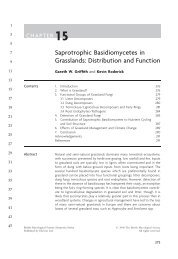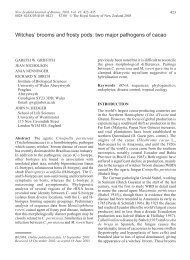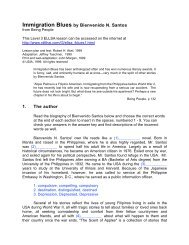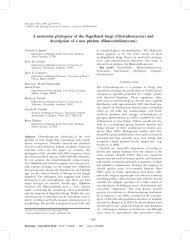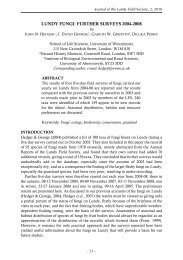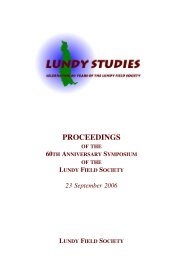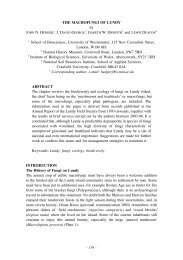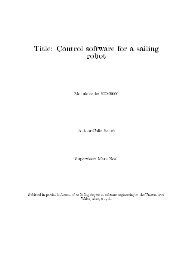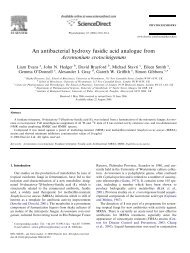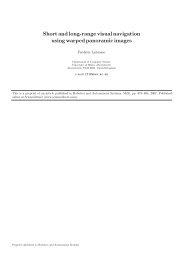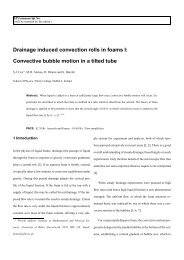Anaerobic rumen fungi
Anaerobic rumen fungi
Anaerobic rumen fungi
You also want an ePaper? Increase the reach of your titles
YUMPU automatically turns print PDFs into web optimized ePapers that Google loves.
ANAEROBIC RUMEN FUNGI<br />
of many distinctive features of anaerobic <strong>fungi</strong> relative to other chytrids, these may be assigned to<br />
a new phylum Neocallimastigomycota phylum nov. (MycoBank no.: MB 501279), containing a single<br />
class Neocallimastigomycetes nov. (MycoBank no.: MB 501280) (Hibbett et al., 2007).<br />
Gold et al (1988) recommended subdivision of anaerobic <strong>fungi</strong> into three genera<br />
Neocallimastix, Piromyces (formerly Piromonas) and Caecomyces (formerly Sphaeromonas).<br />
However, three other genera with more complex growth morphology have subsequently been<br />
discovered i.e. Orpinomyces (Barr et al. 1989), Anaeromyces (Breton et al. 1990) and Cyllamyces<br />
(Ozkose et al. 2001). In all such genera, multiple sporangia are formed in Orpinomyces and<br />
Anaeromyces on a more extensive polycentric thallus. Cyllamyces, like Caecomyces, forms bulbous<br />
holdfasts (which can cause rupture of plant tissues; Joblin, 1989) rather than a rhizoidal system<br />
with up to 12 sporangia formed on branched sporangiophores. Thus, the six genera can be<br />
divided into three groups based on colony morphology (monocentric, polycentric or bulbous).<br />
However, it is likely that zoospore flagellation represents a more fundamental division within the<br />
anaerobic <strong>fungi</strong> with Neocallimastix and Orpinomyces having multiflagellate (5-20 flagella)<br />
zoospores while other genera being uniflagellate. Table 1 represents the classification and<br />
different morphological characteristics of ruminal anaerobic <strong>fungi</strong>.<br />
Kingdom:<br />
Phylum:<br />
Class:<br />
Order:<br />
Genera:<br />
Table 1. Classification and morphological characteristics of anaerobic<br />
<strong>fungi</strong> (after Barr, 1990; James et al., 2000; Hibbett et al., 2007).<br />
A.<br />
B.<br />
Fungi<br />
Neocallimastigomycota<br />
Neocallimastigomycetes<br />
Neocallimastigales<br />
Monocentric: Neocallimastix: zoospore with 4 - 20 flagella;<br />
thallus with filamentous branching rhizoids; Piromyces:<br />
zoospore with 1 - 4 flagella and thallus with filamentous<br />
branching rhizoids, and<br />
Polycentric: Orpinomyces: multiflagellate zoospores;<br />
Anaeromyces: zoospore with single flagellum; Cyllamyces:<br />
zoospore with 1 - 2 flagella with thalloid branched<br />
sporangiophore.<br />
Bulbous: Caecomyces: zoospores with 1 - 2 flagella; thallus with<br />
globular rhizoid; Cyllamyces: zoospore with 1 - 2 flagella,<br />
thalloid branched sporangiophores<br />
Presently, 18 species of anaerobic <strong>fungi</strong> have been identified and described (Table 2). No<br />
anaerobic <strong>fungi</strong> have hitherto, been reported to have a sexual stage.<br />
4. THE LIFE CYCLE<br />
The life cycle of monocentric <strong>fungi</strong> is asexual and shifts between a motile, zoosporic and a<br />
vegetative, zoosporangial stage (Figure 1). The flagellate zoospores move by chemotaxis to<br />
colonize the fibre material (Orpin and Bountiff, 1978; Munn et al. 1988). N. patriciarum zoospores<br />
show chemotaxis towards several carbohydrates as receptors e.g. glucose, mannose, sorbitol and<br />
sucrose (Orpin and Bountiff, 1978), and move across the plant surface, presumably to stumble on<br />
the right location for encystment. After release, these get encysted and germinate exogenously to<br />
form a germ tube from which the rhizoids emerge (Orpin, 1977). The cell mass develops into a<br />
377



